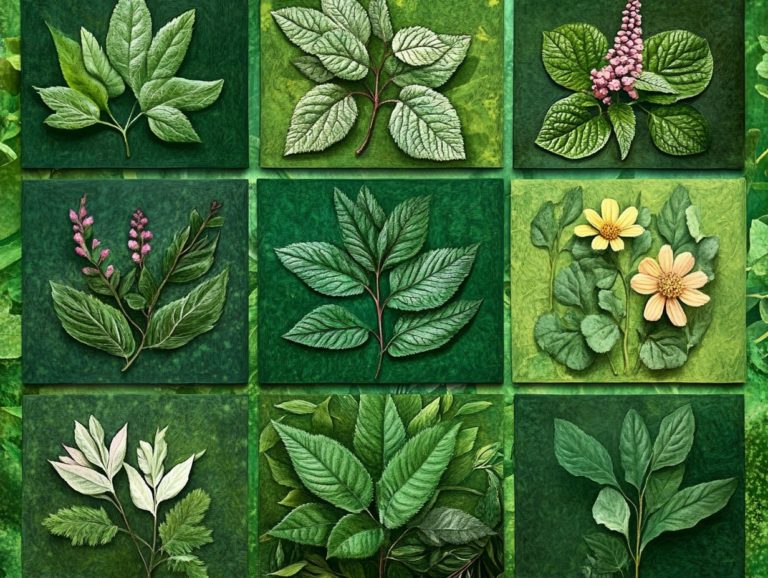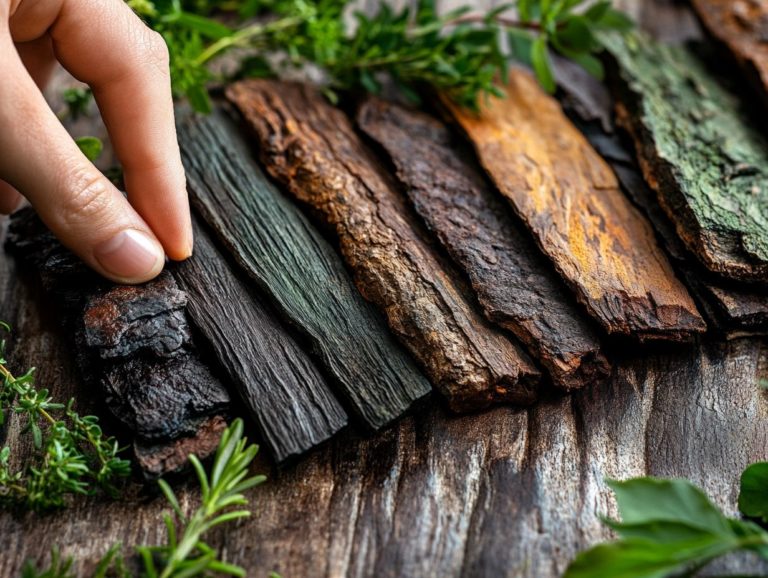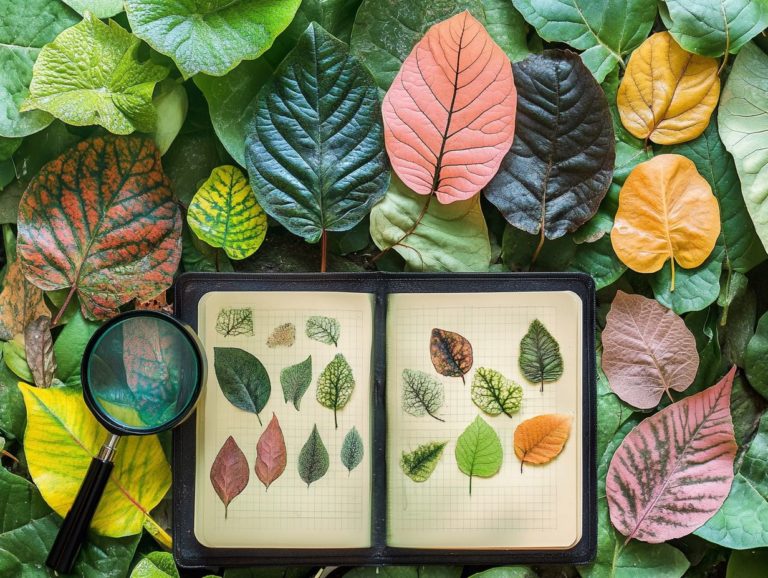5 Edible Plants Found Near Water
Exploring the realm of edible plants often guides you to the verdant landscapes near water bodies, where nature generously presents a treasure trove of delicious and nutritious options.
This article highlights five remarkable plants watercress, lotus, cattails, duckweed, and water chestnuts that flourish in these distinctive habitats. You’ll also find essential tips for safe harvesting and insights into their nutritional benefits, including various edible aquatic plants that can enhance your culinary experience.
Discover how these aquatic delights can transform your cooking adventures!
Contents
- Key Takeaways:
- 1. Watercress
- 2. Lotus
- 3. Cattails
- 4. Duckweed
- 5. Water Chestnuts
- How to Safely Identify and Harvest Edible Plants Near Water?
- What Precautions Should Be Taken When Harvesting Edible Plants Near Water?
- What Are the Nutritional Benefits of Eating Edible Plants Found Near Water?
- Delicious Ways to Prepare Aquatic Plants!
- What Are the Potential Risks of Eating Edible Plants Found Near Water?
- How Can These Plants Be Incorporated into a Balanced Diet?
- Frequently Asked Questions
- What are some examples of edible plants found near water?
- Are there any precautions to take when foraging for edible plants near water?
- How can I identify these edible plants?
- Can I use these plants in cooking?
- Are there any health benefits to eating these plants?
- What are some other uses for these edible plants?
Key Takeaways:
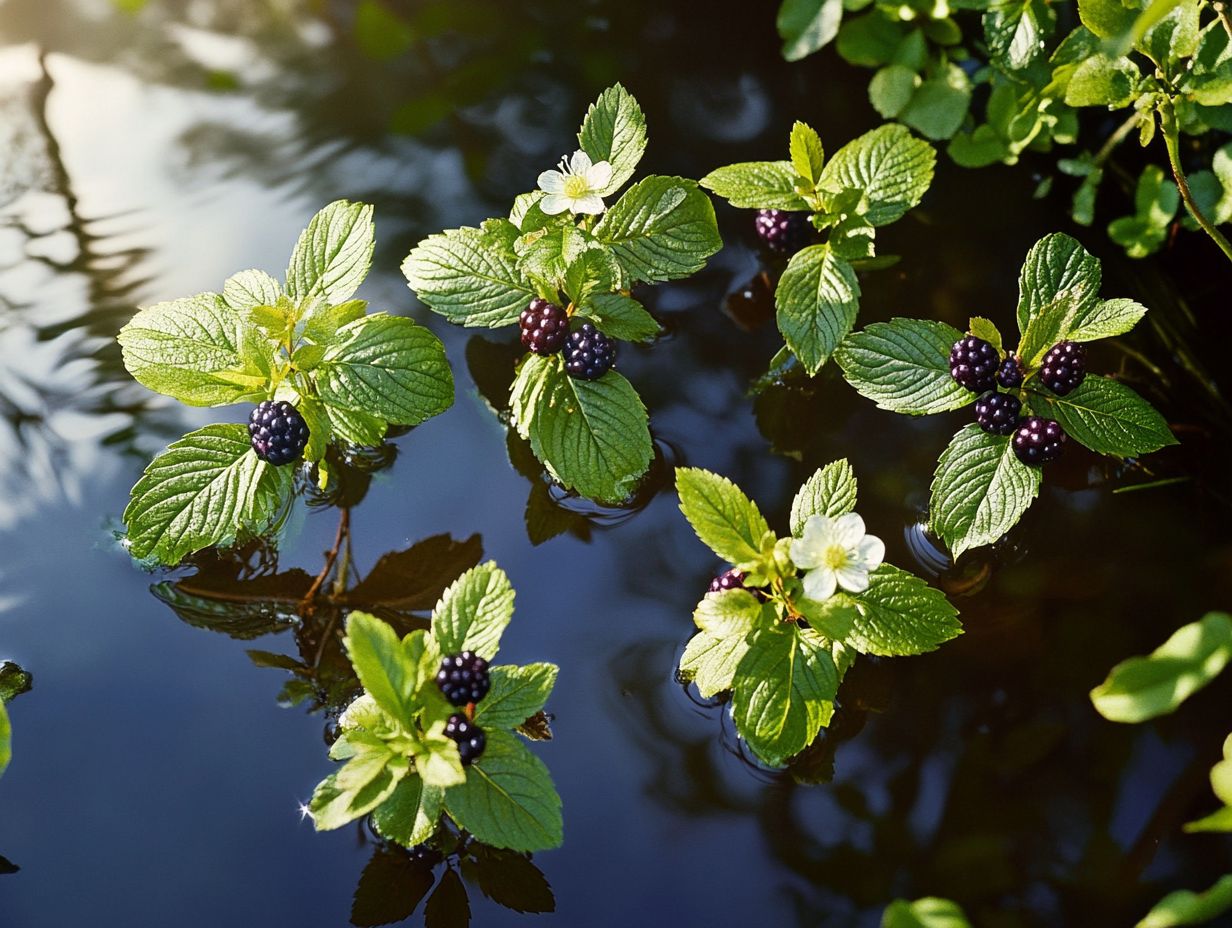
- Watercress, lotus, cattails, duckweed, and water chestnuts are five edible plants that can be found near water sources such as rivers, lakes, and ponds.
- When harvesting these plants, it is important to take precautions and properly identify them to ensure they are safe to consume.
- Edible plants found near water are rich in nutrients and can be incorporated into a balanced diet by preparing and cooking them in various ways.
1. Watercress
Watercress is a nutrient-rich edible aquatic plant that thrives in freshwater. It offers impressive health benefits, making it a great choice for anyone looking to add aquatic plants to their diet.
Loaded with vitamins A, C, and K, this peppery green supports immune health and helps digestion. Its vibrant flavor enhances salads, sandwiches, and soups.
This resilient plant usually grows in cool, flowing water. Wild food foragers appreciate its presence in clean habitats, often noting the unique features of edible plants.
Try blending watercress into a zesty pesto or using it as a seafood garnish. It can shine not just as a garnish but as a main ingredient, showcasing its unique taste and versatility.
2. Lotus
The lotus is not just a sight to behold with its stunning flowers; it s also a treasure trove of edible components and medicinal benefits. This unique plant variety is celebrated across cultures, symbolizing beauty and wellness.
Among its standout edible parts, the seeds and roots of the lotus plant truly shine as nutritional powerhouses. Lotus seeds, with their gentle sweetness, find their way into desserts and soups, offering both delightful flavor and health benefits, including a wealth of protein and minerals. On the other hand, the rhizomes bring a satisfying crunch to salads and stir-fries, elevating your dishes.
Beyond their delicious uses, the lotus holds profound cultural significance, often embodying themes of purity and rebirth in various traditions. Its medicinal properties have been harnessed in traditional practices to boost well-being, aiding digestion and promoting a sense of calm. Embracing the lotus is like inviting a world of beauty and health into your life.
3. Cattails
Cattails, commonly found in wetlands, are versatile edible aquatic plants that offer both sustenance and habitat. Their shoots and roots can be creatively incorporated into various culinary dishes or explored through wild food foraging.
When you harvest the young shoots in spring, you ll discover a mild, slightly sweet flavor reminiscent of fresh cucumber ideal for elevating salads or stir-fries. The roots offer a delightful nutty taste and can be boiled, roasted, or even ground into flour, enhancing a range of dishes. If you re venturing into foraging, it s crucial to identify these plants accurately and collect them from clean water sources to steer clear of any contaminants.
Beyond their culinary uses, cattails play a vital role in their ecosystem. They filter water, provide shelter for wildlife, and help prevent soil erosion. When foraging, remember to wear gloves and ensure you ve identified the plants correctly to safely enjoy this nutritious treasure.
4. Duckweed
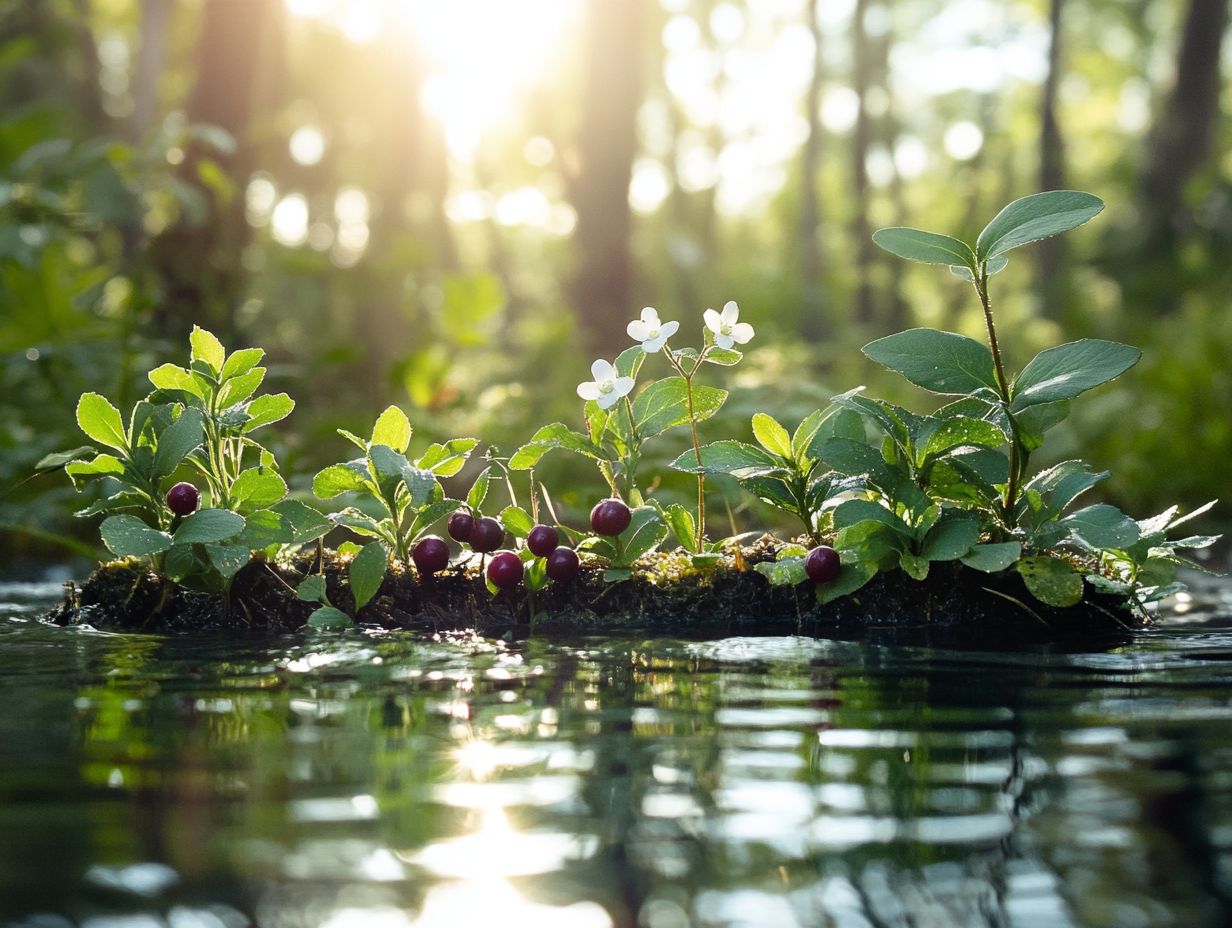
Looking for a nutritional powerhouse? Duckweed is one of the smallest flowering plants. It’s emerging as an edible pond star that boasts impressive health benefits, making it a captivating choice among edible aquatic plants.
Rich in protein, vitamins, and essential amino acids, this petite green wonder delivers a remarkable nutritional boost while remaining low in calories. In the kitchen, duckweed integrates beautifully into salads, soups, and smoothies. Its mild flavor harmonizes seamlessly with other ingredients.
Innovative preparation techniques, such as dehydrating or grinding it into a fine powder, open up a world of creative culinary possibilities. Beyond its kitchen prowess, duckweed shines in sustainable food systems. It grows rapidly, requires minimal agricultural inputs, and absorbs excess nutrients from water systems, contributing positively to environmental conservation.
5. Water Chestnuts
Water chestnuts add a crunchy and refreshing element to dishes. They re not just tasty; they offer great health benefits too!
Packed with essential nutrients, these versatile tubers are low in calories yet rich in fiber, potassium, and vitamins B6 and C, promoting digestive health and overall well-being.
In the culinary realm, water chestnuts truly shine whether in salads, stir-fries, or as a crispy topping for savory creations, they lend a delightful crunch that elevates any dish.
Their significance spans various cultures, especially in Asian cuisines, where they grace traditional dishes like Chinese fried rice and add a delightful touch to spring rolls.
Grow water chestnuts easily by creating a warm, shallow water environment filled with sunlight. This ensures they thrive and produce those delicious, crisp tubers for you to enjoy, alongside other growing aquatic plants that can also flourish in similar conditions.
How to Safely Identify and Harvest Edible Plants Near Water?
Identifying edible plants near water takes careful observation. Knowing what to look for, including unique wild edibles you can find, is essential for safe foraging.
To confidently navigate this intricate landscape, start by looking for visual indicators such as leaf shape, flower color, and growth patterns. These details can provide significant clues about a plant’s edibility. Pay attention to habitat clues, too; factors like soil type and proximity to clean water are vital in discerning safe options.
Safety is key when foraging. Familiarize yourself with which plants are toxic, steer clear of polluted areas, and ensure your harvests are sustainable. This approach protects your well-being and supports the health of the ecosystem.
By honoring these principles, you can savor the rewards of nature while minimizing potential risks.
What Precautions Should Be Taken When Harvesting Edible Plants Near Water?
When harvesting plants near water, take precautions for your safety. Be aware of local wildlife and assess water quality, especially if you’re considering foraging for edible wild greens.
Know your ecosystem. Watch for harmful runoff from nearby agricultural areas that might introduce pollutants into the environment. It s equally important to refrain from overharvesting. Depleting a plant population can disrupt local ecosystems and reduce the resources available for future foragers.
To identify safe harvesting practices, start by learning to distinguish between edible and toxic plants, which can be greatly enhanced by using field guides or joining local foraging groups. Check for signs of pollutants like unusual colors or odors in the water to ensure that the plants you choose to consume are safe and sound.
Get started on your foraging adventure today!
What Are the Nutritional Benefits of Eating Edible Plants Found Near Water?
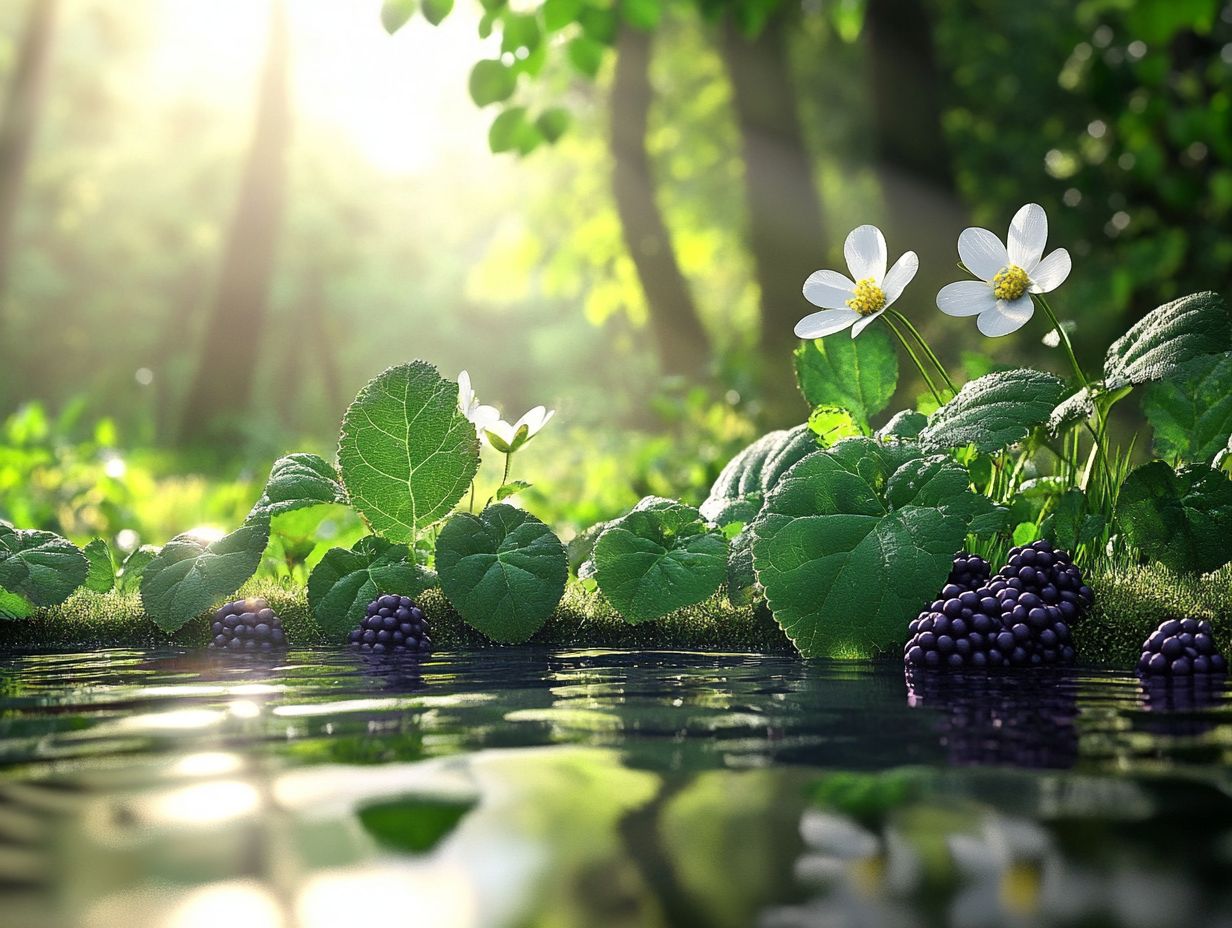
Eating edible plants found in the desert can be a game-changer for your nutrition! They offer a treasure trove of essential vitamins and minerals that support a balanced diet and overall health.
Take watercress, for example. It s celebrated for its high vitamin K content, which is essential for blood clotting and maintaining strong bones. Plus, it s packed with vitamins A and C, both of which boost your immune system.
Then there s the lotus plant. It not only provides fiber for better digestion but is also brimming with antioxidants that help reduce damage caused by free radicals.
Incorporating these aquatic plants into your diet can significantly enhance your health and wellness, serving as a sustainable source of nutrition that benefits both your physical and mental well-being.
Delicious Ways to Prepare Aquatic Plants!
Preparing and cooking aquatic plants can be a delightful culinary adventure! Many edible pond plants offer incredible versatility in the kitchen, allowing for various techniques that enhance their flavors and textures. For those interested in foraging, learning about the 5 essential plants to forage in spring can elevate your cooking experience.
If you’re looking to incorporate these unique ingredients, explore methods like steaming to preserve their delicate taste and nutrients or saut ing them with aromatic herbs and spices. Raw preparations can also be refreshing; imagine tossing fresh watercress in a light vinaigrette to truly enjoy its crispness.
To bring out the essence of these plants, consider a simple recipe that includes:
- Try a steamed lotus root salad drizzled with sesame dressing for a refreshing dish!
- Saut ed duckweed mixed with garlic for a flavorful side.
Each method offers a new way for you to appreciate the natural, subtle flavors that aquatic plants provide.
What Are the Potential Risks of Eating Edible Plants Found Near Water?
While you may find many edible plants thriving near water, it’s essential to recognize the potential risks that come with foraging. Contamination, misidentification, and the presence of harmful species are all factors that require your attention. To get started safely, consider exploring 5 edible plants for beginners to forage.
These risks can be intensified by environmental issues, like pollution in water bodies or the invasive growth of toxic plants that might closely resemble the safe options you seek. To navigate these dangers effectively, it s important for you to educate yourself thoroughly about the local flora. Utilize reputable field guides or apps specifically designed for plant identification. Joining local foraging groups provides invaluable insights from seasoned gatherers.
Remember this key rule: if you’re unsure about a plant’s safety, it’s better to avoid eating it. By taking these precautions, you can significantly enhance your chances of safely enjoying nature s harvest.
How Can These Plants Be Incorporated into a Balanced Diet?
Incorporating edible aquatic plants into your balanced diet can elevate your nutritional variety and health benefits. Understanding the 5 key features of edible plants can help you identify these nutrient-rich options, which add unique flavors and essential nutrients to your diet.
Their versatility makes it effortless for you to include them in your everyday meals. For instance, you can add watercress to a vibrant salad or stir in seaweed for a hearty soup both options enhance flavor and pack in an abundance of vitamins and minerals.
You might also explore meals like stir-fried bok choy or savory aquatic herb frittatas, each offering a rich profile of omega-3 fatty acids and antioxidants. By embracing these aquatic delights, you can savor delicious dishes while reaping the significant nutritional benefits they bring to your table.
Frequently Asked Questions
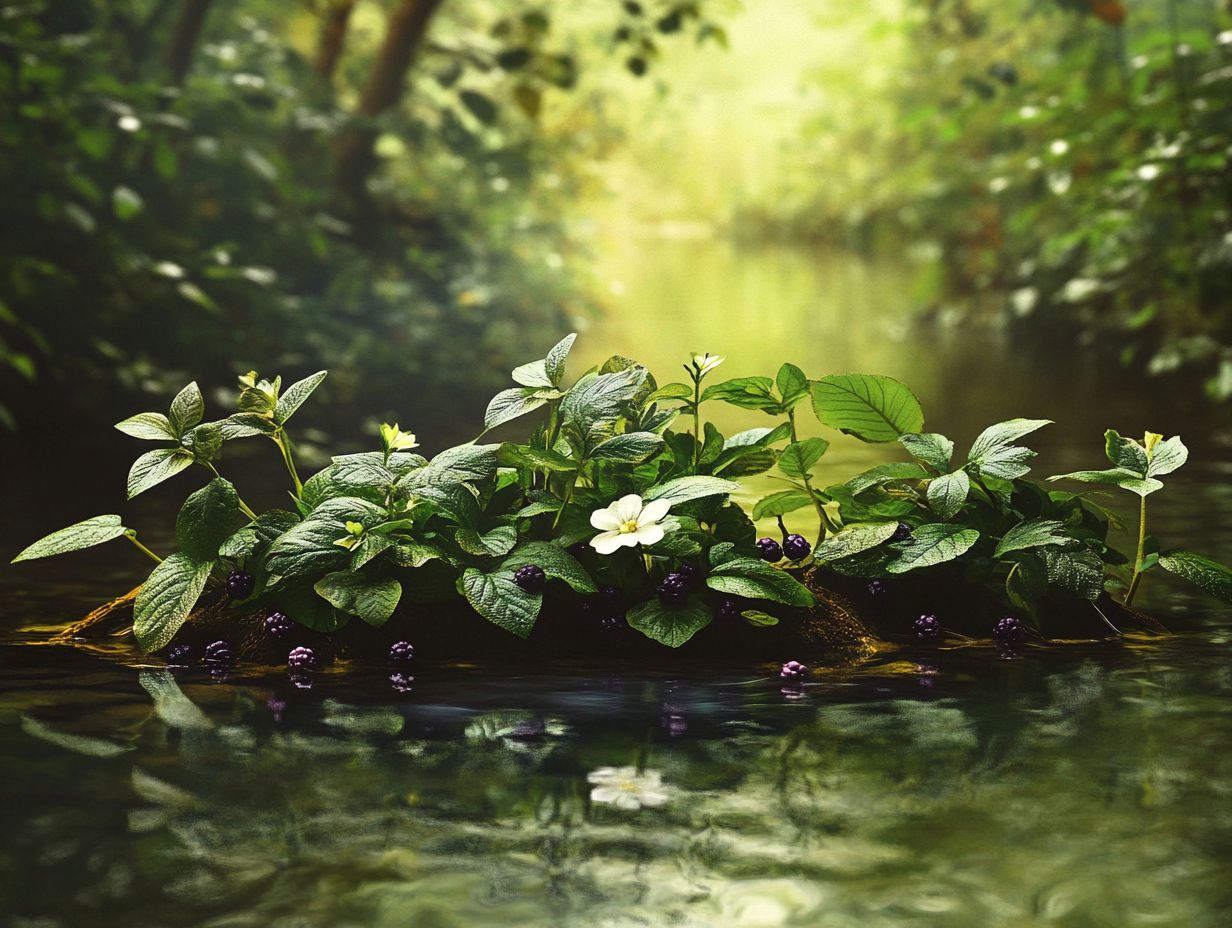
What are some examples of edible plants found near water?
Examples of edible plants near water include cattails, watercress, wild rice, water lilies, and 5 edible plants to find in woodlands, such as duckweed.
Are there any precautions to take when foraging for edible plants near water?
Only eat plants you are absolutely sure are safe.
Avoid picking plants near polluted water or those treated with chemicals.
How can I identify these edible plants?
Do thorough research or forage with an experienced guide for proper identification.
Always double-check your findings with a trusted source.
Can I use these plants in cooking?
Yes, you can cook with these plants.
For instance, cattails can replace corn on the cob, and watercress is great in salads and as a garnish.
Are there any health benefits to eating these plants?
These plants are nutrient-rich and offer health benefits.
Cattails provide carbohydrates and B vitamins, while watercress is high in vitamin C and antioxidants.
What are some other uses for these edible plants?
Besides being edible, these plants can serve other purposes.
Cattails can be woven into baskets, while water lilies are lovely for floral arrangements.


